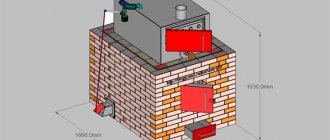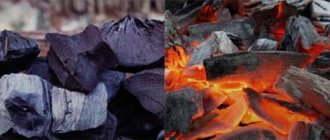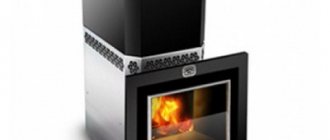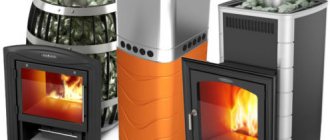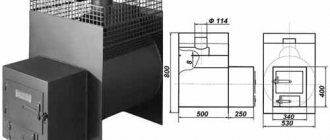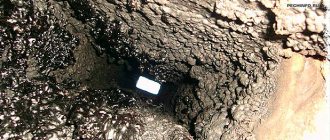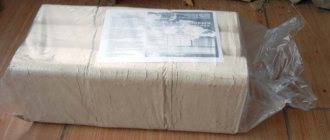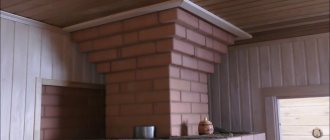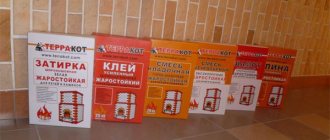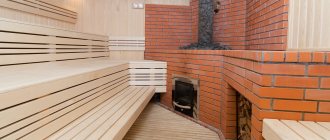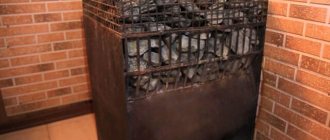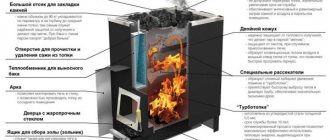Author: Anatoly Smirnov (Moscow)
When creating this design, which would be more correctly called a combined action sauna stove, we took into account the fact that the use of classic varieties of this device entails a number of inconveniences.
When creating this design, which would be more correctly called a combined action sauna stove, we took into account the fact that the use of classic varieties of this device entails a number of inconveniences. Firstly, you can start taking bath procedures only after the fuel has completely burned out or the flaming wood has been forced to be removed, in order to avoid possible burning of people in the steam room. Because of this, the temperature in the heater drops significantly. Secondly, the time during which the bath remains suitable for use is limited by the heat capacity of the stove. And thirdly, the stone backfill requires preliminary cleaning of soot deposits, which is achieved by “steaming” with the subsequent removal of the soot vapor cloud from the room.
The proposed sauna stove with turbocharging successfully solves the first two problems and, for the most part, eliminates the third. The main design elements are screw-type valves, which hermetically close the heater after preparation for bath procedures and release smoke into the bypass channel, and a fan, which ensures the operation of the forced turbocharging system. Along with the presence of additional smoke circulation units, which make it possible to effectively use the secondary heat of flue gases, this approach allows you to speed up the heating of the steam room and increase the temperature in it, as well as create a more gentle operating mode for the stove with noticeable savings in firewood. In addition, a heat exchanger (heat register) is built into the combustion part, which serves to heat the water before it is supplied through the tap to the stone backfill.
When igniting wood in the firebox, valves 1, 4 and 5 should be opened, and when the combustion mode has been established, valve 4 must be closed. When the steam room is ready to receive procedures, the stove is switched to idle mode, for which you will have to close valve 1 and open valve 2. After this, with the heater door closed and valve 4 open, the user must clean the stone backfill from soot deposits by briefly opening the hot water tap . Next, valve 4 closes, completely isolating the stones from the flow of flue gases that will pass through the bypass channel, nevertheless continuing to heat the bathhouse. When the temperature in the steam room drops, it is enough to reconnect the tank with stone filling to the existing smoke circulation system by opening valves 1, 3 and 5 while valve 4 is closed.
The combustion part of the stove is lined with refractory bricks, and the gap between the outer walls of the firebox and the inner surface of the main structure is 5–7 mm. The necessary tightness of the masonry and places of fastening of metal parts is achieved through supersil - silica fiber, which can withstand temperatures up to 1200°C.
Operating modes of brick sauna stoves
According to the method of heating the stones and, accordingly, the operating mode, brick stoves for baths are divided into 2 types: continuous and periodic stoves . Regardless of the operating mode, protective screens are not required for brick sauna stoves.
Continuous ovens
The stones in such stoves are kept in an insulated metal box above the firebox. In this design, the stones are protected from soot, but they heat up slightly, only up to 300-350 degrees. The stones used are fine, the size of coarse crushed stone.
The main advantage of continuous stoves is that you can use the steam room during the combustion process ; you do not have to wait until the fuel burns out completely, as is necessary in the case of intermittent stoves.
Batch ovens
The stones in these stoves are also located above the firebox, but not in an insulated box, but on a metal grate. The stones are heated by flue gases passing through them; the temperature of the stones reaches 1000 degrees.
Due to this design, you can use the steam room only some time after the fuel has completely burned so that all the carbon monoxide has time to escape. The stones used in such ovens are large and round in shape. The total weight of the stones is at least 50 kg.
Back to contents
Features of lining protection
Under conditions of regular use, the materials from which the stove is made are exposed to extremely high temperatures, varying depending on the type of fuel used. The internal surfaces of the firebox are subject to cracking, and, in the case of metal products, excessive permanent heating and constant “expansion-compression” cycles lead to its gradual destruction. High temperatures typically occur when coal is used, although pallets often cause excessive heat. Extreme temperatures are not the only factor that negatively affects the surfaces of metal or brick stoves. The lining is also used for:
- As thermal insulation, protecting against temperature fluctuations.
- As protection against aggressive environments. (acid fuel reagents).
- Protection against mechanical damage to the firebox.
- As a facing material.
Which oven should you choose?
It would seem that batch stoves are not as convenient to use as, for example, gas sauna stoves or gas-wood stoves for a sauna. To some extent, this is true, but a real Russian bath is obtained only with periodic brick stoves , since only these stoves provide that “light” steam without jumps in humidity in the steam room.
Constant heating stoves are more suitable for dry saunas , where high temperature is important and there is practically no humidity.
Back to content
Did you like the article? Recommend to friends:
Advantages of a brick sauna stove
- High strength. The period of operation will be very long, since the brick is subject to wear and tear for a long time.
- Safety. Thanks to the production of this building material from natural raw materials, human health is not exposed to any danger.
- It takes a long time to cool down. This allows you to wash in a warm bath even six hours after running it, the water will remain warm. Although it will take quite a long time to heat up (about three hours).
- There is no need for additional fire safety measures.
- You can heat a large space.
Methods of execution
The lining of the fireplace is usually carried out using so-called “fireclay” materials - specially processed substances and their mixtures with the inclusion of firing elements, which destroy the plastic properties and lead to sintering of their particles, as well as other refractory products. It can be:
- Hewn stone made from natural rock such as sandstone or quartz, or conglomerate, resistant to particularly high temperatures.
- Ready-made fireclay bricks, from which the inner wall is laid. Their fire-resistant properties are achieved thanks to a special manufacturing technology with the addition of powder from pre-fired clay and other substances that improve the properties of the final product. Protection made from such bricks is very popular, as it can withstand almost any temperature of a heating furnace and is relatively cheap.
- Rolled materials, plates and mats: basalt fiber,
- vermiculite boards,
- kaolin in the form of paper or cardboard, consisting of the mineral white clay.
- fireclay, which is fire-resistant concrete with the addition of a waste component,
Vermiculite finishing can be an excellent alternative to brick and stone
About glue and mortar
In addition to the quality and technical characteristics of the materials, the durability and efficiency of the furnace lining is influenced by their correct installation. Any violations in the technology of internal cladding of the firebox can lead to a change in the properties and structure of the surrounding building materials, and the release of carbon monoxide into living rooms.
Solution
When the firebox is coated with heat-resistant solutions, a monolithic, very thin protective layer is formed on the walls, which is the best protection for the working surface from the effects of fire. However, such a monolith will require repairs faster than masonry made from piece products.
There are several rules for making linings using this technology:
- Prepare a solution from dry mixtures of fireclay, mullite or corundum type, diluted with water to the consistency of thick sour cream. They are usually sold in paper packaging, which contains information about the proportions of the components, the characteristics of the mixture, and the manufacturer’s instructions for use.
Consistency of lining solution - The applied layer of solution is first burned with a blowtorch or by briefly heating the oven until a hard crust is formed.
- When lining a furnace with fireclay bricks, the joints must be filled to the full height of the masonry.
The consumption of the finished mortar per 1 m³ of brickwork is approximately 100 kg.
Fireproof glue
Fireproof adhesive for lining is sold in plastic containers weighing 2 - 50 kg. Before starting lining work, the bucket of glue must be opened and the contents mixed until completely homogeneous.
Further:
- The adhesive mass is applied only to the pre-moistened surface with a spatula. The layer thickness should not exceed 3 mm.
- If you plan to coat the entire firebox cavity with glue, then the coating is done in layers with a time interval between applications of at least 15 minutes.
- To glue basalt cardboard to horizontal sections, the adhesive composition can be diluted with water by 15%, but no later than 12 hours before starting to work with the glue.
- Depending on the structure of the surface being treated and the thickness of the adhesive layer, from 1 to 4 kg of glue is consumed per 1 m².
- The time for complete hardening of a layer of adhesive mass with a thickness of 3 mm at temperatures above 25ºC is 24 hours, at temperatures above 90ºC - 6 hours.
Types of lining
Lining work is carried out directly inside the firebox of metal, stone and brick devices. This can be done in different ways depending on what effect is expected and what goals are to be achieved:
- It is possible to use special protective screens with heat-insulating effect. They will influence the percentage of heating of the flue gases, absorbing a significant part of the radiant heat fluxes and removing most of the heat through the chimneys.
- The use of materials that will absorb most of the thermal impact - fire-resistant with low thermal conductivity, slowing down the heating process of the firebox materials and excluding their direct contact with fire.
Lining work in a brick firebox is carried out by laying out brickwork.
ATTENTION! Heat-insulating screens significantly reduce heat transfer, so they are not used for fireboxes intended for heating rooms.
Lining Instructions
To install the lining of a home stove, it is better to use the services of specialists, but if you have at least minimal skills and diligence, this type of work of a stove master can be done with your own hands.
Brick kiln
The lining of a brick kiln firebox using fireclay is performed as follows:
- First row. Fireclay bricks are laid edgewise around the grates. It is preferable that the brick product have an inclined edge to ensure a slope towards the grate.
- The second row of rear and side walls rises simultaneously. The brick is also laid edgewise with a shift of ½ length relative to the block in the bottom row. The seam is reinforced with steel wire with a diameter of 3 mm or 5 mm.
- Subsequent rows are performed in the same way up to the top of the combustion chamber. Reinforce the seams through one row of masonry.
- Lastly, the upper surface of the firebox is lined, laying the brick flat. Between the layers of lining and the main masonry, thermal insulation is made of asbestos. If the vault has a convex shape, the masonry is carried out using shaped (three-sided wedge or pentagonal) bricks.
Example of lining with fireclay bricks
Example 2
Example 3
Example 4
In this case, it must be taken into account that the lining layer and the main masonry of the walls must coincide in the location of the vertical seams and not have any bandaging.
Metal furnaces
The lining of the fireboxes of metal furnaces is carried out in the same way as in brick chambers (instructions above), but with one difference: there should be a small gap between the walls made of metal and fireclay bricks to compensate for linear expansion. Basalt or kaolin slabs and asbestos sheets are laid in this space. External cladding is not recommended with brick due to its low thermal conductivity.
Metal furnace lining
One more example
Solid fuel boiler
In boilers, the coolant passes through heat exchange channels and loses almost no energy to heat the walls of the housing. This feature of solid fuel equipment is taken into account when constructing the lining.
This is done in one of three ways:
- Heavy lining. Used for devices with weak shielding. With this method, the internal lining of the firebox is made of two or three layers of fireclay masonry.
- Lightweight lining. Single-layer brickwork is placed inside the combustion chamber. The outside of the boiler is lined with heat-insulating products that can withstand high temperatures and sheathed with sheet steel.
- Pipe lining. The boiler pipes are coated on the outside with fire-resistant glue and mortar in 3-4 layers reinforced with fiberglass mesh. After hardening, a monolithic thick layer is formed, protecting against unnecessary heat loss.
Clay ovens
The lining of the fireboxes of molded clay furnaces is carried out with fireclay bricks. The exception is a stove made of a clay-sand mixture and reinforced with stone. It can be coated with plastic refractories: aluminosilicate glue or mastic. After hardening, a layer of such lining material forms a continuous shell that reliably protects the clay walls from overheating.
